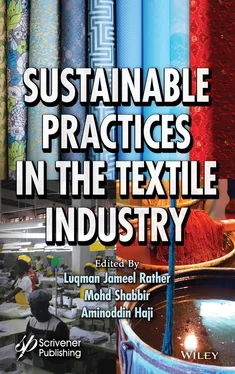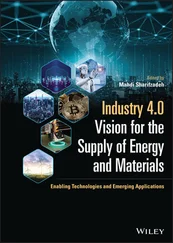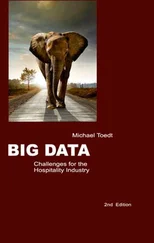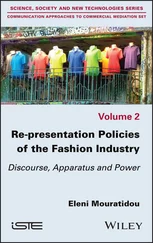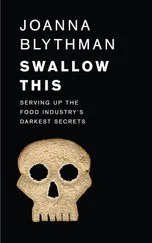Sustainable Practices in the Textile Industry
Здесь есть возможность читать онлайн «Sustainable Practices in the Textile Industry» — ознакомительный отрывок электронной книги совершенно бесплатно, а после прочтения отрывка купить полную версию. В некоторых случаях можно слушать аудио, скачать через торрент в формате fb2 и присутствует краткое содержание. Жанр: unrecognised, на английском языке. Описание произведения, (предисловие) а так же отзывы посетителей доступны на портале библиотеки ЛибКат.
- Название:Sustainable Practices in the Textile Industry
- Автор:
- Жанр:
- Год:неизвестен
- ISBN:нет данных
- Рейтинг книги:5 / 5. Голосов: 1
-
Избранное:Добавить в избранное
- Отзывы:
-
Ваша оценка:
- 100
- 1
- 2
- 3
- 4
- 5
Sustainable Practices in the Textile Industry: краткое содержание, описание и аннотация
Предлагаем к чтению аннотацию, описание, краткое содержание или предисловие (зависит от того, что написал сам автор книги «Sustainable Practices in the Textile Industry»). Если вы не нашли необходимую информацию о книге — напишите в комментариях, мы постараемся отыскать её.
Sustainable Practices in the Textile Industry
Sustainable Practices in the Textile Industry — читать онлайн ознакомительный отрывок
Ниже представлен текст книги, разбитый по страницам. Система сохранения места последней прочитанной страницы, позволяет с удобством читать онлайн бесплатно книгу «Sustainable Practices in the Textile Industry», без необходимости каждый раз заново искать на чём Вы остановились. Поставьте закладку, и сможете в любой момент перейти на страницу, на которой закончили чтение.
Интервал:
Закладка:
78. Kulkarni, S.S., Gokhale, A.V., Bodake, U.M., Pathade, G.R., Cotton dyeing with natural dye extracted from pomegranate ( Punica granatum ) Peel. Universal J. Environ. Res. Technol ., 1, 135, 2011.
79. Srivastava, A., Priyanka, Parmar, M.S., Eco-friendly dyeing of natural fabrics using discarded litchi fruit peel., 2012. https://www.fibre2fashion.com/industry-article/6402/eco-friendly.
80. Jain, H., Dyeing of cotton fabrics with extracts of jamun tree and its products using natural mordants. Colourage , 60, 40, 2013.
81. Mohammad, S.I., Sarker, P., Mamun, A.A., Iqbal, S.M.F., Influence of natural mordants in coloration of cotton knitted fabric with mango seed kernel extract dyes. Int. J. Curr. Eng. Technol ., 10, 358, 2020.
82. Rachel, D.A. and Hussain, B.M.Z., Healthcare textile dyed natural socks. Int. J. Res. Trends Innovation , 4, 79, 2019.
83. Chandel, S., Patel, J., Chauhan, A., Organic dye extraction from Brassica oleracea var. botrytis (cauliflower). Int. Res. J. Eng. Technol ., 6, 498, 2019.
84. Singam, R.T., Marsi, N., Mamat, H., Rus, A.Z.M., Nasir, S.H., Shaari, M.F., Physical properties of natural dyes based on Lawsonia inermis , Azadiractha indica and Curcuma longa coated with superhydrophobic coating for textile applications. Int. J. Adv. Res. Eng. Technol ., 11, 301, 2020.
85. Pan, N.C., Chattopadhay, S.N., Day, A., Dyeing of jute with natural dyes. Indian J. Fibre Text. Res ., 28, 339, 2003.
86. Mathur, J.P., Mehta, A., Karnawat, R., & Bhandari, C.S.., Use of neem bark as wool colourant Optimum conditions of wool dyeing. Indian J. Fibre Text. Res ., 28, 94-99, 2003.
87. Bechtold, T. and Mahmud-Ali, A., Mussak, Reuse of ash-tree ( Fraxinus excelsior L.) bark as natural dyes for textile dyeing: Process conditions and process stability. Color. Technol ., 123, 271, 2007.
88. Jayalakshmi, I. and Amsamani, S., Dyeing wool using biomordants. Colourage , 55, 102, 2008.
89. Mohammad, F., Yusuf, M., Shahid, M., Khan, S.A., Khan, M.I., Shahidul, I., Khan, M.A., Dyeing of wool with the extract of henna leaves using mixed metal mordants. Colourage , 59, 51, 2012.
90. Uddin, M.G., Extraction of eco-friendly natural dyes from mango leaves and their application on silk fabric. Text Cloth Sustain , 1, 7, 2015.
91. Swamy, V.N., Assessment of calorimetric, antibacterial and fastness properties of silk fabric dyed with Casuarina equisetifolia L. leaf extract. Indian J. Tradit. Knowl ., 16, 714, 2017.
92. Banerjee, A.N., Kotnala, O.P., Maulik, S.R., Dyeing of eri silk with natural dyes in presence of natural mordants. Indian J. Tradit. Knowl ., 17, 396, 2018.
93. Shukla, P., Upreti, D.K., Nayaka, S., Tiwari, P., Natural Dyes from Himalayas Lichens. Indian J. Tradit. Knowl ., 13, 195, 2014.
94. Khan, M.A., Khan, M., Srivastava, P.K., Mohammad, F., Extraction of natural dyes from myrobalan, gallnut and pomegranate, and their application on wool. Colourage , 52, 53, 2005.
95. Lokhande, H.T. and Dorugade, V.A., Dyeing nylon with natural dyes. Am. Dyest. Rep ., 88, 29, 1999.
96. Miah, M.R., Zakaria, Hossain, M.A., Dipto, A.I., Telegin, F.Y., Quan, H., Ecodyeing of nylon fabric using natural dyes extracted from onion outer shells: assessment of the effect of different mordant on color and fastness properties. Int. J. Sci. Eng. Res ., 7, 1043, 2016.
97. Purwar, S., Application of natural dye on synthetic fabrics: A review. Int. J. Home Sci ., 2, 283, 2016.
98. Elnagar, K., Elmaaty, T.A., Raouf, S., Dyeing of polyester and polyamide synthetic fabrics with natural dyes using ecofriendly technique. Journal of Textiles , 2014, 8, 2014.
99. Shahin, M.F., Ahmed, R.M., Marie, M.M., Optimizing the dyeing process of alkali-treated polyester fabric with dolu natural dye. Int. J. Eng. Res. Appl ., 4, 35, 2014.
100. Guizhen, K., Dyeing properties on natural dye extracted from Rhizoma coptidis on acrylic fiber. Indian J. Fiber Text. Res ., 39, 102, 2014.
101. Pruthi, N., Chawla, G.S., Yadav, S., Dyeing of silk with Barberry bark dye using mordant combination. Nat. Prod. Radiance , 7, 40–44, 2008.
102. Iqbal, S. and Ansari, T.N., Natural dyes: Their sources and ecofriendly use as textile materials. J. Environ. Res. Dev ., 8, 683, 2014.
103. Shabbir, M., Islam, S.U., Bukhari, M.N., Application of Terminalia chebula natural dye on wool fiber–Evaluation of color and fastness properties. Text. Cloth. Sustain ., 2, 1, 2017.
104. Susmitha, S., Vidyamol, K.K., Ranganayaki, P., Vijayaragavan, R., Phytochemical extraction and antimicrobial properties of Azadirachta indica (Neem). Global J. Pharmacol ., 7, 316, 2013.
105. Feng, X.X., Zhang, L.L., Chen, J.Y., Zhang, J.C., New insights into solar UV-protective properties of natural dye. J. Cleaner Prod ., 15, 366, 2007.
106. Grifoni, D., Bacci, L., Zipoli, G., The role of natural dyes in the UV protection of fabrics made of vegetable fibres. Dyes Pigm ., 91, 279, 2011.
107. Mongkholrattansit, R., Krystufek, J., Wiener, J., Vikova, M., Dyeing, fastness and UV protection properties of silk and wool fabrics dyed with eucalyptus leaf extract by the exhaustion process. Fibres Text ., 86, 94, 2011.
108. Desore, A. and Narula, S.A., An overview on corporate response towards sustainability issues in textile industry. Environ. Dev. Sustainability , 20, 1439, 2018.
109. Bhatia, S. C., Pollution control in textile industry. WPI Publishing. New Delhi, 2017.
110. Hossain, M.S., Das, S.C., Islam, J.M., Al Mamun, M.A., Khan, M.A., Reuse of textile mill ETP sludge in environmental friendly bricks–effect of gamma radiation. Radiat. Phys. Chem ., 151, 77, 2018.
111. Muthu S.S., Introduction. In: Sustainability in the Textile Industry , Muthu S. (Ed.). pp. 1–7, Textile Science and Clothing Technology. Springer, Singapore, 2017.
112. Setiadi, T., Andriani, Y., Erlania, M., Treatment of textile wastewater by a combination of anaerobic and aerobic processes: A denim processing plant case, in: Southeast Asian Water environment (Biodiversity and Water environment) , S. Ohgaki, K. Fukushi, H. Katayama, S. Takizawa, C. Polprasert (Eds.), p. 159–166, IWA Publishing, Oxford, 2006.
113. Vigneshpriya, D. and Shanthi, E., Physicochemical Characterization of Textile Wastewater. Int. J. Innovative Res. Dev ., 4, 48, 2015.
114. Mahapatra, N.N., Textile dyes , p. 1–7, CRC Press, Woodhead Publishing India Pvt, Boca Raton, 2016.
115. Hassan, M.M. and Carr, C.M., A critical review on recent advancements of the removal of reactive dyes from dye house effluent by ion-exchange adsorbents. Chemosphere , 209, 201, 2018.
116. Shamey, R. and Zhao, X., Modelling, simulation and control of the dyeing process , p. 31–53, Elsevier, Amsterdam, 2014.
117. Imran, M., Crowley, D.E., Khalid, A., Hussain, S., Mumtaz, M.W., Arshad, M., Microbial biotechnology for decolorization of textile wastewaters. Rev. Environ. Sci. Biotechnol ., 14, 73, 2015.
118. Aquino, J.M., Rocha-Filho, R.C., Ruotolo, L.A., Bocchi, N., Biaggio, S.R., Electrochemical degradation of a real textile wastewater using β-PbO2 and DSA® anodes. Chem. Eng. J ., 25, 138, 2014.
119. Khatri, J., Nidheesh, P.V., Singh, T.A., Kumar, M.S., Advanced oxidation processes based on zero-valent aluminium for treating textile wastewater. Chem. Eng. J ., 348, 67, 2018.
120. Sandhya, S., Biodegradation of azo-dyes under anaerobic condition: Role of azoreductase, in: Biodegradation of Azo-dyes , H.A. Erkurt (Ed.), p. 39–57, Springer, Berlin, 2010.
Читать дальшеИнтервал:
Закладка:
Похожие книги на «Sustainable Practices in the Textile Industry»
Представляем Вашему вниманию похожие книги на «Sustainable Practices in the Textile Industry» списком для выбора. Мы отобрали схожую по названию и смыслу литературу в надежде предоставить читателям больше вариантов отыскать новые, интересные, ещё непрочитанные произведения.
Обсуждение, отзывы о книге «Sustainable Practices in the Textile Industry» и просто собственные мнения читателей. Оставьте ваши комментарии, напишите, что Вы думаете о произведении, его смысле или главных героях. Укажите что конкретно понравилось, а что нет, и почему Вы так считаете.
